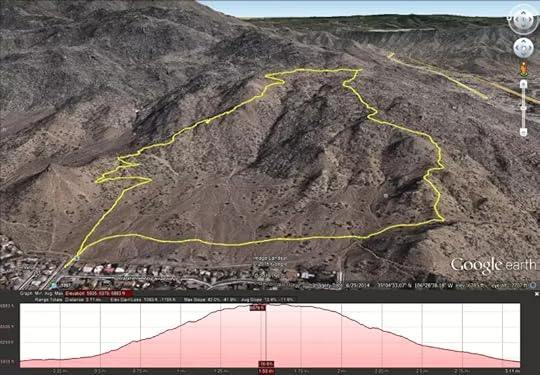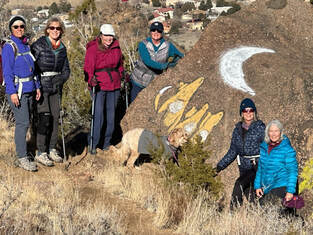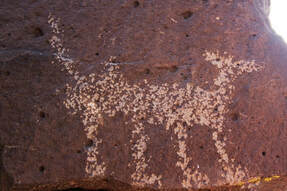The Writing on the Wall
 Last month, my hiking group did the short but steep climb up to the Eye of the Sandias, a bit of graffiti in the southern Sandia Mountains, overlooking Tijeras Canyon and the village of Carnue.
Last month, my hiking group did the short but steep climb up to the Eye of the Sandias, a bit of graffiti in the southern Sandia Mountains, overlooking Tijeras Canyon and the village of Carnue. Where this painting came from is a mystery. In Sandia Mountain Hiking Guide, Mike Coltrin says “The Eye appeared sometime in the 1960s, but the originator is unknown.”
One blogger calls the painting an adaptation of an ancient Egyptian symbol of protection, power and health, the Eye of Horus. The artist, or some later artist, made the eye New Mexican by substituting a Zia Sun symbol for the pupil. Several sources suggest that the teardrops show the mountain's grief over the encroachment of suburbia or the roar of I-40 through the canyon below it.
 source: https://pngyoung.com/Hiking/eye-of-th... The hike is not an easy one. It gains almost a thousand feet in a distance just over three miles. Some of the trails have slopes approaching 45% and are covered with granite gravel that rolls underfoot. But the views are worth it.
source: https://pngyoung.com/Hiking/eye-of-th... The hike is not an easy one. It gains almost a thousand feet in a distance just over three miles. Some of the trails have slopes approaching 45% and are covered with granite gravel that rolls underfoot. But the views are worth it. Our group parked at the trailhead parking lot at the top of Copper. We walked the loop trail going clockwise to avoid going down the steepest parts.
Our group parked at the trailhead parking lot at the top of Copper. We walked the loop trail going clockwise to avoid going down the steepest parts.On our way up, we also encountered this rock art, which depicts three coyotes howling at the moon. It is decidedly modern, but the coyote pictured below, which is from the La Cieneguilla Petroglyph Site, west of Santa Fe isn't.
 https://naturetime.wordpress.com/2012... New Mexico has thousands of petroglyphs and pictographs. Some were created by ancient cultures: the Ancestral Puebloan and Mogollon Indians. Later, Apaches and Navajos added their contributions. Early Spanish explorers, and then Anglo frontiersmen, bored cowboys left their marks and initials on rocks. As the Eye of the Sandia proves, the art of embellishing rocks continues. New Mexico's rock art stretches back into prehistoric times, but is still new compared to rock art in other parts of the world. The island of Sulawesi, in Indonesia has some rock art that is at least 45,500 years old. .The cave paintings at Chauvet Cave in modern day France were created sometime between 43,000 and 65,000 years ago. That's 20,000 years before the first modern humans arrived in Europe. The oldest known cave paintings, those from La Pasiega, Maltravieso and Ardales, in modern day Spain, were created at least 64,000 years ago, and most likely by Neanderthals. It appears that the desire to decorate rock is older than modern man.
https://naturetime.wordpress.com/2012... New Mexico has thousands of petroglyphs and pictographs. Some were created by ancient cultures: the Ancestral Puebloan and Mogollon Indians. Later, Apaches and Navajos added their contributions. Early Spanish explorers, and then Anglo frontiersmen, bored cowboys left their marks and initials on rocks. As the Eye of the Sandia proves, the art of embellishing rocks continues. New Mexico's rock art stretches back into prehistoric times, but is still new compared to rock art in other parts of the world. The island of Sulawesi, in Indonesia has some rock art that is at least 45,500 years old. .The cave paintings at Chauvet Cave in modern day France were created sometime between 43,000 and 65,000 years ago. That's 20,000 years before the first modern humans arrived in Europe. The oldest known cave paintings, those from La Pasiega, Maltravieso and Ardales, in modern day Spain, were created at least 64,000 years ago, and most likely by Neanderthals. It appears that the desire to decorate rock is older than modern man.
 My dual timeline novel The Last Song of the Swan retells the story of Beowulf, an Old English epic about a hero who destroys a monster that is raiding a Danish mead-hall. One of the timelines in the novel is modern: a present day high school girl who must write a paper on Beowulf and wonders about the characters. The other timeline is set deep into prehistory, at a time when Neanderthals and modern men co-inhabited those parts of Europe that weren't covered in sheets of ice. My son, the artist Matt Bohnhoff, created modern cave art interpretations to introduce each chapter, and to embellish the cover: rock art that never appeared on rock, but on paper.
My dual timeline novel The Last Song of the Swan retells the story of Beowulf, an Old English epic about a hero who destroys a monster that is raiding a Danish mead-hall. One of the timelines in the novel is modern: a present day high school girl who must write a paper on Beowulf and wonders about the characters. The other timeline is set deep into prehistory, at a time when Neanderthals and modern men co-inhabited those parts of Europe that weren't covered in sheets of ice. My son, the artist Matt Bohnhoff, created modern cave art interpretations to introduce each chapter, and to embellish the cover: rock art that never appeared on rock, but on paper.
 Jennifer Bohnhoff writes historical and contemporary fiction for middle grade through adult readers. She lives in the mountains of central New Mexico, but hikes wherever trails, rock art, and beauty can be found.
Jennifer Bohnhoff writes historical and contemporary fiction for middle grade through adult readers. She lives in the mountains of central New Mexico, but hikes wherever trails, rock art, and beauty can be found.
Published on March 14, 2023 08:38
No comments have been added yet.



